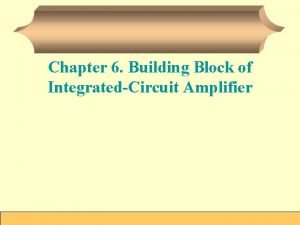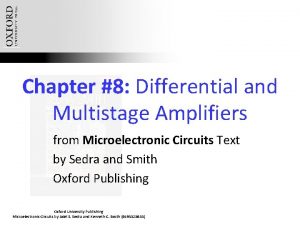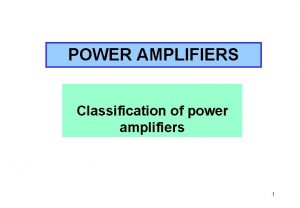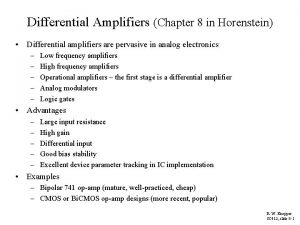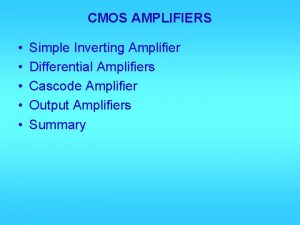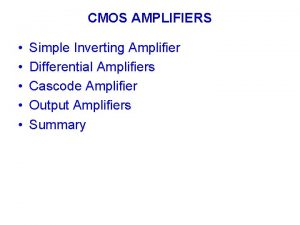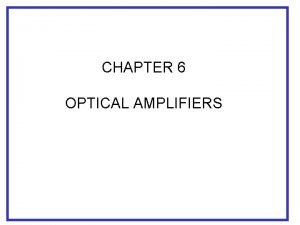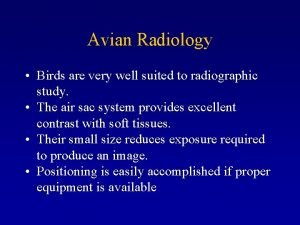Differential Amplifiers Why differential Well suited for integrated










- Slides: 10

Differential Amplifiers Why differential? • Well suited for integrated circuit (IC) fabrication • Less sensitive to noise • Possibility to couple amplifier stages without capacitors Figure 7. 1 The basic MOS differential-pair configuration. 1

Operation with a Common-Mode Input Voltage Figure 7. 2 The MOS differential pair with a common-mode input voltage v. CM. 2

Operation with a Differential Input Voltage Figure 7. 4 The MOS differential pair with a differential input signal vid applied. With vid positive: v. GS 1 > v. GS 2, i. D 1 > i. D 2, and v. D 1 < v. D 2; thus (v. D 2 - v. D 1) will be positive. With vid negative: v. GS 1 < v. GS 2, i. D 1 < i. D 2, and v. D 1 > v. D 2; thus (v. D 2 - v. D 1) will be negative. 3

Large-Signal Operation Figure 7. 5 The MOSFET differential pair for the purpose of deriving the transfer characteristics, i. D 1 and i. D 2 versus vid = v. G 1 – v. G 2. 4

Figure 7. 6 Normalized plots of the currents in a MOSFET differential pair. Note that VOV is the overdrive voltage at which Q 1 and Q 2 operate when conducting drain currents equal to I/2. 5

Figure 7. 7 The linear range of operation of the MOS differential pair can be extended by operating the transistor at a higher value of VOV. 6

Small-Signal Operation of The MOS Differential Pair Differential Gain Figure 7. 8 Small-signal analysis of the MOS differential amplifier: (a) The circuit with a common-mode voltage applied to set the dc bias voltage at the gates and with vid applied in a complementary (or balanced) manner. (b) The circuit prepared for small-signal analysis. 7

Common-Mode Gain and Common-Mode Rejection Ratio Figure 7. 10 (a) The MOS differential amplifier with a common-mode input signal vicm. (b) Equivalent circuit for determining the common-mode gain (with ro ignored). Each half of the circuit is known as the “common-mode half-circuit. ” 8

The BJT Differential Pair Figure 7. 12 The basic BJT differential-pair configuration. 9

Figure 7. 14 Transfer characteristics of the BJT differential pair of Fig. 7. 12 assuming a. 1. 10
 Pea plants were particularly well suited
Pea plants were particularly well suited Pea plants were particularly well suited
Pea plants were particularly well suited Figure 17-3 shows smaller and larger beaks
Figure 17-3 shows smaller and larger beaks Building blocks of integrated-circuit amplifiers中文
Building blocks of integrated-circuit amplifiers中文 Cmfb fully-differential amplifiers
Cmfb fully-differential amplifiers Differential and multistage amplifiers
Differential and multistage amplifiers Differential and multistage amplifiers
Differential and multistage amplifiers Differential and multistage amplifiers
Differential and multistage amplifiers Pictures
Pictures Classification of power amplifier
Classification of power amplifier Power absorbed or delivered
Power absorbed or delivered



